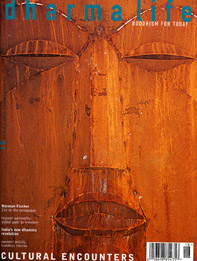Shoes outside the Door
Desire, devotion and excess at San Francisco Zen Center
Michael Downing
Counterpoint 2001, $26/£18.38 h/b
The shoes referred to in the title of Michael Dowling's chronicle of the lives and times of the San Francisco Zen Center are those of Anna Hawken. The door is that of Richard Baker's house at Tassajara, the San Francisco Zen Center's rural extension in the Santa Cruz mountains. The occasion is a peace conference held at Tassajara in March 1983.
Why this date and occurrence are central to the story of the San Francisco Zen Center is the theme of the book. Michael Dowling, who declares himself 'not a Buddhist', is a novelist who happened upon this story. The style in which he relates it is that of 'new journalism', in which the observer self-consciously places himself in the context of the narrative.
Dowling covers the period from the arrival of Shunryu Suzuki (Suzuki Roshi) in San Francisco in 1959 through to the present. By far the bulk of the book, however, is taken up with events from Suzuki Roshi's death in 1971 until Richard Baker's departure from San Francisco in 1984. The story is constructed around March 1983 as a climax on which those involved look back.
The story begins when Shunryu Suzuki, a somewhat obscure Soto Zen priest from the Japanese countryside, was posted to a small congregation of Japanese Buddhists in San Francisco. His arrival coincided with the interest in Zen Buddhism of the American Beat Generation. Within a couple of years he had an active following in the young progressive population who were flocking to San Francisco as a haven of the new cultural values. Several of these young people took the study of Zen very seriously, going so far as to study in Japan, especially at Eihiji, the monastery Dogen founded in the 13th century. Richard Baker was among these. He eventually became Suzuki Roshi's head student and then Dharma heir.
The issue of transmission figures as a central theme in the book. The preoccupation of the Zen tradition as it was conveyed to the West with the legitimising of an intact direct lineage back to the Buddha shadows the events narrated. The other primary subtext has to do with ethics and power.
Which brings us back to the shoes ...
Anna Hawken was the wife of Paul Hawken, the progressive businessman whose garden supply business, Smith & Hawken, was a model for a new form of doing business, and who subsequently has become a spokesperson and activist for enlightened social and economic activities. He was also Richard Baker's 'best friend.' Baker and Anna Hawken were having an affair that was quite evident to witnesses. The Hawkens built a house at Tassajara. So the Abbot of the monastery was having extra-marital sex in his private home with his best friend's wife.
The survivors are still debating how he and the community had got into this position and what the general response should have been. That he had a vast amount of power and prestige is in no doubt. What is debated is the relationship between this and his having been given transmission by Suzuki Roshi.
Transmission, of course, is seen to acknowledge the recipient's awakening, which is to say Enlightenment itself. The question of whether those who have not had this experience, or at least not received public recognition for having done so, have the right to question 'Enlightened beings' lies at the heart of the matter.
The usual triad of sex, money and power is at the root of it all. Richard Baker had built the San Francisco Zen Center into an influential network of centres, businesses and individuals, stretching across the continent. Had he been less problematic in his practice, would he have been less accomplished? The parallels to the issues in the life of Chogyam Trungpa are noticeable.
Having been an outlying hanger-on to the Zen Center at that time, I found the book an intriguing chronicle of those halcyon days. It is structured around interviews with several dozen of the inner circle at the Center and with Richard Baker himself. It is moving to witness people trying to come to grips with a cataclysmic event in their collective lives, and one cannot help but admire the determination with which they have tried to make sense of it all. Highly recommended reading.
Amara



